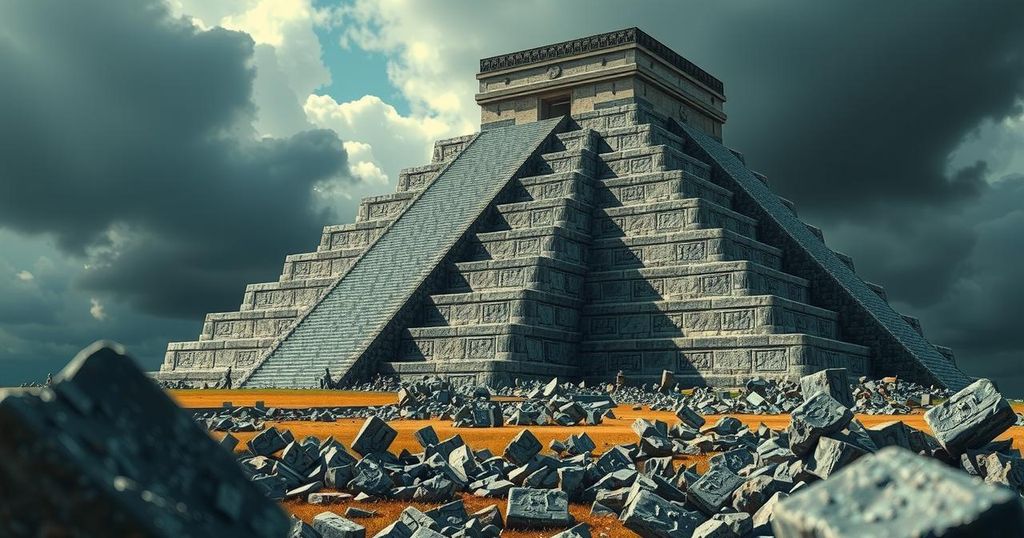Collapse of Ancient Pyramid in Mexico Highlights Climate Change Crisis

A stone pyramid in Michoacán, Mexico, collapsed following extreme weather in July 2024, a stark illustration of climate change’s impact on cultural heritage. As rainfall followed a significant drought, the structure, historically important to the P’urhépecha civilization, showed signs of deterioration, leading to its eventual downfall. This incident reflects broader threats to archaeological sites worldwide, raising urgent questions about preservation amid escalating climate risks.
In a striking manifestation of the effects of climate change, a historic stone pyramid in Michoacán, Mexico, collapsed on July 29, 2024, due to intense storms and prolonged rainfall. Stretching approximately 15 meters high, it once stood as a testament to the enduring legacy of the Michoacán Kingdom civilization. The ancient structure, part of the archaeological site at Ihuatzio, had suffered previous wear but ultimately succumbed under the relentless pressure from the elements. Although only one pyramid was directly affected, reports from Mexico’s National Institute of Anthropology and History (INAH) indicated that at least six other structures were in varying states of disrepair. The recent destructive weather mirrored the extremes of the Northern Hemisphere summer, where heavy rainfall followed a historically severe drought that had plagued the region. INAH attributed the pyramid’s downfall to the resultant cracks exacerbated by high temperatures, which allowed water infiltration into the vulnerable pre-Hispanic monument. As officials begin restoration efforts, they stress the importance of preserving the cultural heritage that such structures embody for future generations. This incident is not singular; climate change continues to gravely affect archaeological sites worldwide, with similar degradation observed in ancient cave paintings in Oceania, among other locations. The precarious state of heritage developments, highlighted by recent studies, demonstrates that increased precipitation increases the risk of damage to historical buildings globally. Commenting on the cultural significance of the collapse, Tariakuiri Alvarez, a member of the P’urhépecha tribe, stated that such events would have been deemed a “bad omen” by his ancestors, reflecting a historical belief tied to human conditions and divine displeasure. Additionally, just days prior, the famed ‘Double Arch’ in Utah also fell victim to climate-related changes, underscoring a broader environmental crisis. As we witness the gradual demise of such irreplaceable historical sites, it becomes imperative to reflect on the consequences of human-induced climate alteration. The preservation of these priceless cultural artifacts not only serves historical continuity but also echoes the responsibility held by society in safeguarding our shared heritage for future generations.
The recent collapse of an ancient pyramid in Michoacán, Mexico, serves as a critical reminder of the impact of climate change on heritage sites. With severe weather patterns becoming more prevalent, monuments that have stood for centuries are now at risk due to factors such as intense rainfall and rising sea levels. The site at Ihuatzio, which boasts several significant structures from the P’urhépecha civilization, exemplifies the vulnerability of historical landmarks against the backdrop of a changing climate. This occurrence illustrates a broader trend affecting numerous archaeological sites around the world, prompting urgent discussions on preservation strategies amidst escalating environmental concerns.
The collapse of the pyramid in Michoacán is emblematic of a growing crisis, wherein climate change threatens the existence of invaluable cultural heritage. As weather extremes continue to ravage historical sites, we face an urgent imperative to rethink our approaches to preservation and the impacts of our environmental policies. By recognizing the significance of these cultural landmarks and learning from past mistakes, society can work towards their protection, ensuring that future generations can inherit and appreciate this rich heritage. The voices of those who understand the cultural implications, such as Tariakuiri Alvarez, highlight the intersection of cultural significance and environmental awareness, urging a type of reverence for our collective history.
Original Source: www.sciencealert.com








